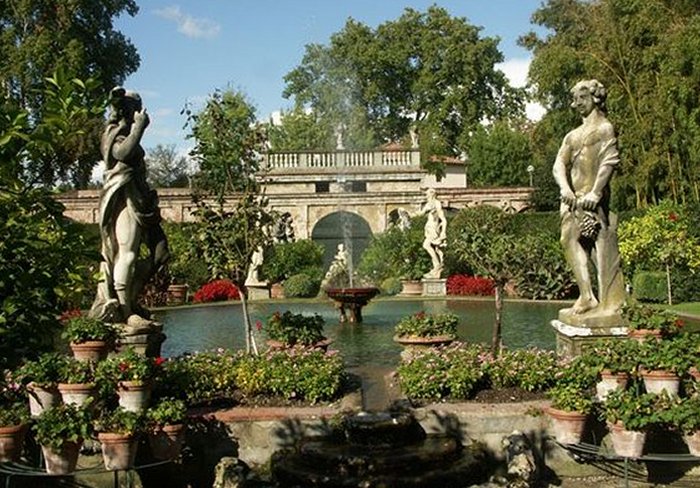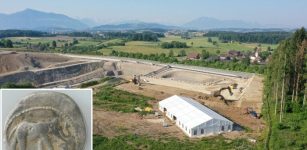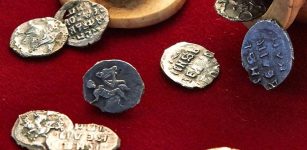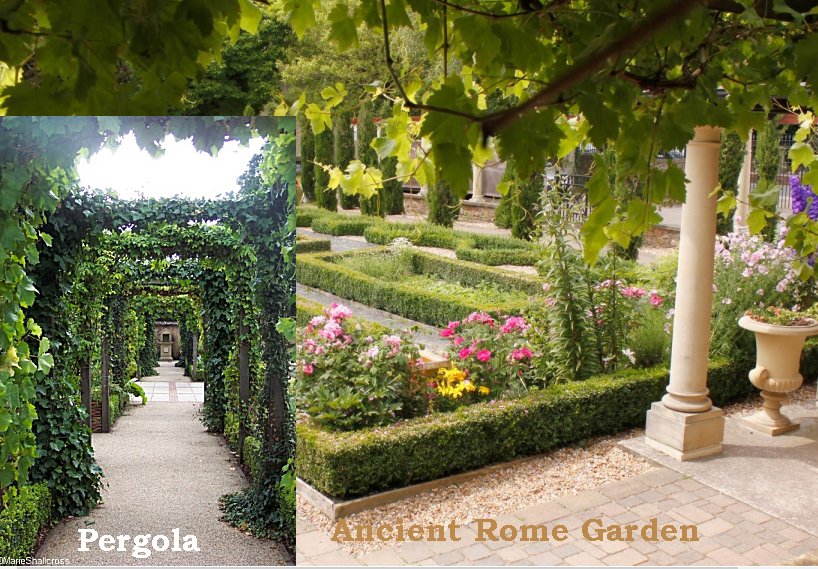How Did Ancient Romans Grow Their Gardens?
AncientPages.com - The Roman garden culture was significantly developed after 60 BC. Roman gardens were influenced by Egyptian, Persian, and Greek gardening techniques.
Each area in the garden had its special function. The owner could use his garden’s shaded path (gestation) to ride horseback or be carried by slaves.

The large gardens in the city's edge were extensive parks with pavilions, statues and spring water. Source
The gardens gave flowers for wreaths that were used at parades and religious festivals in ancient Rome.
Most gardens had a pergola, a shaded walkway, passageway, or sitting area surrounded by vertical pillars covered with growing vines.
While in China pergolas were built to provide shade in temples and living spaces, in ancient Egypt they were used to provide both shade and to house figs and grapes.
The Romans used pergolas for growing vines, which were often seen climbing many pergolas and providing a green shade especially during a romantic meal for two or a larger family.
A large and lush garden gave status and prestige to the Romans. In the shady environment, the master of the house could relax or have guests, while slaves did the hard work of cultivating the soil and taking care flowers (usually roses, violets, and oleanders) and tall trees along with a variety of dwarf trees.
The large gardens in the city's edge were extensive parks with pavilions, statues and spring water. Some even had their own zoo. Rare plants housed during travel or field trains gave special status. The garden was not only used to boast. Archaeological finds show that the Romans both ate and worked in it. The women used to weave outdoors in the shade of the trees.
See also:
Why Did Ancient Romans Build So Many Straight Roads?
Ancient Roman Women Wore Bikini In 1400 B.C.
First Pay Toilets Were Invented In Ancient Rome In 74 A.D.
Families who had houses built on small pieces of land, usually could set up miniature gardens or satisfied themselves with beautiful murals, which gave the illusion of that the house was surrounded by a lush pond.
The peasants of medieval Europe considered their gardens an important source of food and herbs to cure all sorts of diseases. In the upper class, however, the garden became a fashion phenomenon during the late Middle Ages.
Garden played an important role in people’s daily life; rich people discussed all the new tricks and tips to drive out the best vegetables and the trees that gave the most fruit.
Most excavated Roman gardens show straight paths, however, serpentine or curved paths were also designed especially in larger gardens.
Pliny (AD 23–79), a Roman author, naturalist and natural philosopher, wrote that his villa at Laurentum, on the west coast of the Italian Peninsula southwest of Rome, had only one wide path that circled around a central bed, while his stadium garden in Tuscany had several different paths. (Pliny Epistulae 2).
Copyright © AncientPages.com All rights reserved. This material may not be published, broadcast, rewritten or redistributed in whole or part without the express written permission of AncientPages.com
Expand for referencesReferences:
Katharine T. von Stackelberg, The Roman Garden: Space, Sense, and Society
Bowe P. Gardens of the Roman World
More From Ancient Pages
-
 Did Lead Pollution Cause IQ Declines Among Ancient Romans?
Places | Jan 8, 2025
Did Lead Pollution Cause IQ Declines Among Ancient Romans?
Places | Jan 8, 2025 -
 Is This The Face Of A 16th Century Pirate Or Criminal?
Archaeology | Jan 5, 2016
Is This The Face Of A 16th Century Pirate Or Criminal?
Archaeology | Jan 5, 2016 -
 518-Million-Year-Old-Rocks Suggest Animal And Human Life May Have First Emerged In China – Scientists Say
News | Apr 19, 2022
518-Million-Year-Old-Rocks Suggest Animal And Human Life May Have First Emerged In China – Scientists Say
News | Apr 19, 2022 -
 Scythian Gold-Plated Sword ‘Akinakes’ Unearthed In Southern Ukraine
Archaeology | Oct 25, 2019
Scythian Gold-Plated Sword ‘Akinakes’ Unearthed In Southern Ukraine
Archaeology | Oct 25, 2019 -
 Has The Legendary Viking Stronghold Jomsborg Finally Been Found?
Archaeology | Jun 3, 2023
Has The Legendary Viking Stronghold Jomsborg Finally Been Found?
Archaeology | Jun 3, 2023 -
 Why Are The 2,000-Year-Old Roman Walls Found In Switzerland An ‘Archaeological Sensation’?
Archaeology | Sep 15, 2023
Why Are The 2,000-Year-Old Roman Walls Found In Switzerland An ‘Archaeological Sensation’?
Archaeology | Sep 15, 2023 -
 Unusual Underwater Archaeological Discovery In California May Confirm Thousand-Year-Old Legend And Re-Write Ancient History
Featured Stories | Aug 15, 2024
Unusual Underwater Archaeological Discovery In California May Confirm Thousand-Year-Old Legend And Re-Write Ancient History
Featured Stories | Aug 15, 2024 -
 Legend Of Gyanganj – Antediluvian City Of Immortal Sages That Can Only Be Found By The Chosen Ones
Featured Stories | Jul 29, 2017
Legend Of Gyanganj – Antediluvian City Of Immortal Sages That Can Only Be Found By The Chosen Ones
Featured Stories | Jul 29, 2017 -
 Ancient Societies Ruled By Ruthless Dictators – Collapsed
Civilizations | Oct 18, 2020
Ancient Societies Ruled By Ruthless Dictators – Collapsed
Civilizations | Oct 18, 2020 -
 Lofn ‘Matchmaker’ – Norse Goddess Of Forbidden Marriages Of People Who Wish To Be Loved And Search For Partners
Featured Stories | Mar 25, 2021
Lofn ‘Matchmaker’ – Norse Goddess Of Forbidden Marriages Of People Who Wish To Be Loved And Search For Partners
Featured Stories | Mar 25, 2021 -
 Amanirenas – Fearless Queen Of Kush Who Defeated Ancient Romans
Featured Stories | Jan 30, 2019
Amanirenas – Fearless Queen Of Kush Who Defeated Ancient Romans
Featured Stories | Jan 30, 2019 -
 Mawangdui Medical Manuscripts: Oldest Surviving Anatomical Atlas In The World
News | Sep 2, 2020
Mawangdui Medical Manuscripts: Oldest Surviving Anatomical Atlas In The World
News | Sep 2, 2020 -
 Ancient Tomb Of Peru’s Moche Priestesses Unearthed
Archaeology | Jul 23, 2016
Ancient Tomb Of Peru’s Moche Priestesses Unearthed
Archaeology | Jul 23, 2016 -
 Silver Coins Hidden In Chess Figure Date Back To Ivan The Terrible’s Days – Discovery In Moscow
Archaeology | May 13, 2017
Silver Coins Hidden In Chess Figure Date Back To Ivan The Terrible’s Days – Discovery In Moscow
Archaeology | May 13, 2017 -
 Power Of Water In Beliefs Of Ancient Cultures
Featured Stories | Apr 9, 2019
Power Of Water In Beliefs Of Ancient Cultures
Featured Stories | Apr 9, 2019 -
 On This Day In History: William Laud Archbishop Of Canterbury Beheaded – On Jan 10, 1645
News | Jan 10, 2017
On This Day In History: William Laud Archbishop Of Canterbury Beheaded – On Jan 10, 1645
News | Jan 10, 2017 -
 A Painted Vault Lid Discovered In Royal Palace Of Ek’ Balam Will Shed Light On History Of The Acropolis Of Ek’
Archaeology | Sep 16, 2023
A Painted Vault Lid Discovered In Royal Palace Of Ek’ Balam Will Shed Light On History Of The Acropolis Of Ek’
Archaeology | Sep 16, 2023 -
 Madagascar Hippos Were Forest Dwellers – New Study
Fossils | Jul 8, 2023
Madagascar Hippos Were Forest Dwellers – New Study
Fossils | Jul 8, 2023 -
 12th Century Idol Of Vishnumurthy Unearthed In Abandoned Well Near Udupi, India
Archaeology | Feb 26, 2021
12th Century Idol Of Vishnumurthy Unearthed In Abandoned Well Near Udupi, India
Archaeology | Feb 26, 2021 -
 More Than 10,000 Pre-Columbian Earthworks Remain Hidden Throughout Amazonian Forests
Archaeology | Oct 5, 2023
More Than 10,000 Pre-Columbian Earthworks Remain Hidden Throughout Amazonian Forests
Archaeology | Oct 5, 2023

